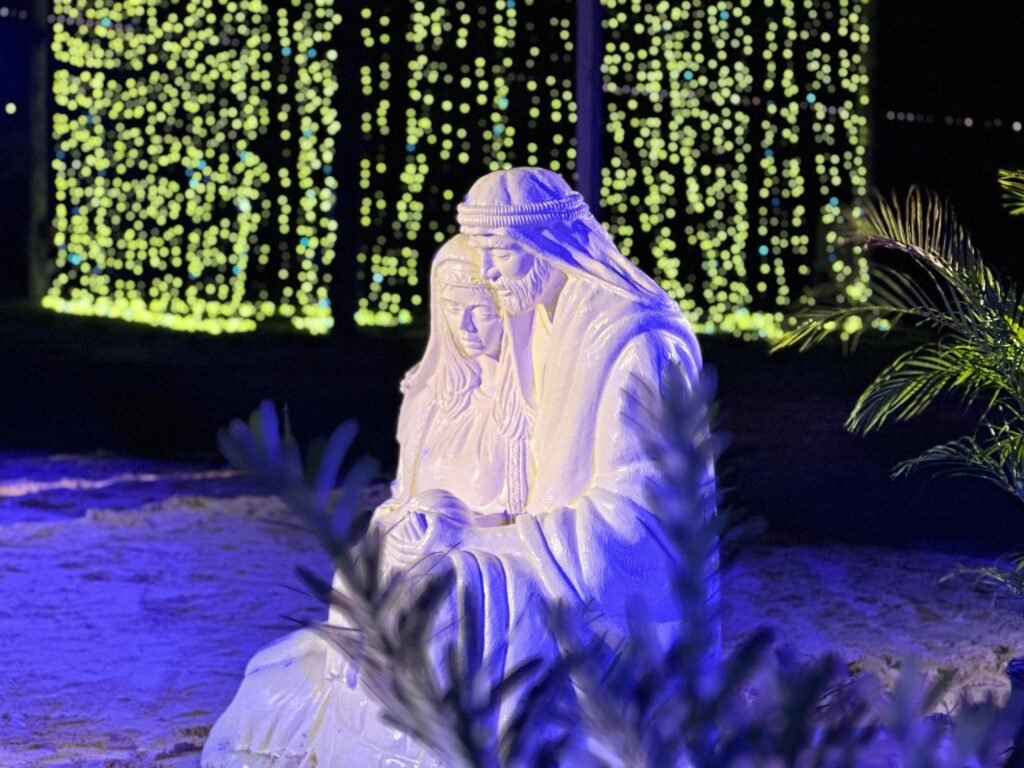Atmosphere is more than ambiance. It’s more than setting a mood. In ministry, atmosphere becomes a silent shepherd—it guides people into openness, stillness, expectancy. It begins before the first lyric or line is delivered, and it continues shaping hearts even after the experience ends. It’s the first sermon the room preaches.
One of my favorite examples to share was at the immersive nativity experience at a Christmas experience I produced called Lone Star Lights. Without a single word spoken, guests were ushered into the reality of the incarnation. They walked among shepherds and wise men. They stood near the holy family.

And somehow, without a script or stage cues, the moment carried sacred weight. You could feel it in the stillness. You could see it in the expressions on people’s faces. The creativity didn’t distract—it invited. It opened hearts in ways no paragraph ever could—though we included excerpts of Scripture too. At each area, guests could read the Christmas story from a different perspective—shepherd, wise man, Mary, Joseph—anchoring their experience in the Word. And the atmosphere wasn’t accidental. Lighting subtly shifted to guide movement and evoke reverence. A gentle audio bed helped ground the space emotionally. Every detail worked in harmony to usher people into the story—not to tell it for them, but to let them step inside it.
That’s what intentional atmosphere does. It communicates before words. It softens defenses and makes space for encounter. And it’s not limited to physical space. Atmosphere is carried in how a video is paced, how a photo is framed, how a visual sequence feels. It’s in the tone of the narration, the textures of the sound design, the space between elements on a graphic.
When we teach our teams about atmosphere, we talk about the five primary senses—sight, sound, touch, smell, and even taste. These aren’t just sensory checkpoints; they’re storytelling tools. Sight might mean the lighting and visual cues, but it also includes typography, composition, and the colors chosen to reflect a theme. Sound could be a live music moment or a thoughtfully mixed score under a video. Touch could be the texture of printed materials or the weight of a handcrafted element. Smell and taste—when used—have the power to root experiences in memory.
We ask questions like: How does the environment look? What story does the lighting tell, and how does the visual rhythm of the space guide someone emotionally? What does it sound like—are we drawing people in with a soft score or awakening them with bold clarity? What does it feel like to walk in—to touch the seat, the program, the air itself? Is it warm and welcoming, reverent and still, expectant and vibrant? What story are we telling—not just with content, but with design, tone, movement, and presence? And what emotions are we inviting? Awe? Rest? Celebration? Conviction? What do we hope someone feels when they enter—and how do we want them to feel when they leave? Inspired? Seen? Awakened? Sent? Every sensory decision should be made with those outcomes in mind.
Atmosphere is built with layers—each one offering a chance to shape experience, stir emotion, and signal intention. Visuals draw the eye, but they also direct attention and posture. Sound carries tone, but it also anchors rhythm and mood. Touch, smell, and taste—all invite embodiment. When these layers are carefully attended to, they don’t just enhance an experience; they ready the heart. Creativity becomes more than a design function. It becomes a sacred tool. It becomes a conduit for presence—a way to meet people in the margins of a moment—those unscripted, unnoticed spaces where something sacred can still take root, to stir something unspoken, to signal that they are seen and welcomed. It’s the gentle nudge of grace wrapped in beauty, the unforced invitation into something sacred. And when done well, it doesn’t direct attention to the creativity itself—it directs hearts toward Jesus.
Atmosphere is not an accessory to ministry. It is a form of ministry. Because atmosphere is often the first thing someone encounters—it’s the first element to break through resistance and the first invitation extended. And yes, I believe it’s a form of spiritual formation. Atmosphere sets a tone that lingers—it helps calibrate the soul before a single word is spoken. It creates an emotional and spiritual runway, aligning hearts with what God might want to do. It shapes people’s posture toward God, not by demanding response, but by nurturing readiness. It builds expectation, awakens wonder, and opens the door to transformation long before any message is delivered. And sometimes, there may be no spoken message at all— it may be an event, an experience, a gathering where creativity becomes the carrier of meaning and encounter. Whether it’s a seasonal walkthrough like Lone Star Lights or a quiet moment at a summer camp, the same principles apply: the Spirit moves through what’s been prepared with care..
Creativity, when wielded intentionally, can reach places words may never go. It speaks the language of the heart, bypassing logic and argument to touch something deeper—something sacred. It slips past the mind’s defenses, disarming resistance not with force but with beauty. And because creative expressions are interpreted differently by each person, they become deeply personal. A photo might remind someone of their own longing. A lyric might echo an unspoken prayer. A design might bring clarity to a chaotic heart. It’s the quiet, wonder-filled mystery of how God uses beauty not to impress, but to invite. Not to demand, but to draw us gently closer to Himself.
